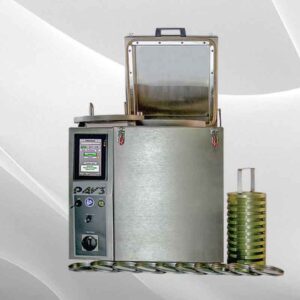Description
When it comes to asphalt testing, achieving quality results is crucial for the long-term performance of roadways, pavements, and other infrastructure. One of the key instruments that plays a pivotal role in this process is the Pressure Aging Vessel (PAV). In this comprehensive guide, we will delve into the significance of the PAV, its operation, and how it influences the quality and durability of asphalt materials.
Understanding the Pressure Aging Vessel (PAV)
The Pressure Aging Vessel, or PAV, is a specialized device used in the testing of asphalt binder materials. Its primary purpose is to simulate the natural aging process that asphalt binders undergo over time due to exposure to environmental factors such as temperature, oxygen, and ultraviolet (UV) radiation. By replicating these aging conditions in a controlled laboratory setting, engineers and researchers can better predict the long-term performance of asphalt materials.
Optimizing the Use of PAV in Asphalt Testing
Optimizing the use of a pressure aging vessel is essential to ensuring the accuracy of asphalt test results. Here’s how the PAV works and why it’s critical in the asphalt industry:
- Simulating Real-World Conditions: PAV subjects asphalt binders to high pressure and elevated temperatures, typically at 100 psi and 240°C (464°F). This simulates the aging process that asphalt undergoes during its service life, helping to predict how the material will perform in the field.
- Measuring Physical Properties: During the PAV test, various physical properties of the asphalt binder are analyzed, including the change in viscosity, ductility, and other rheological properties. These measurements help researchers understand how the binder will behave under different environmental conditions.
- Predicting Aging Characteristics: By collecting data from PAV tests, engineers can predict the aging characteristics of asphalt binders, such as their susceptibility to oxidative hardening, embrittlement, and other forms of deterioration. This information is vital for selecting appropriate binders for specific projects.
- Evaluating Material Durability: PAV tests provide insights into the durability and long-term performance of asphalt binders. This information is invaluable for designing asphalt mixtures that can withstand the challenges of various climates and traffic loads.
- Quality Assurance: The data obtained from PAV testing helps ensure the quality and longevity of asphalt pavements. By optimizing the use of PAV, engineers can make informed decisions about binder selection and pavement design, leading to safer and more reliable roadways.
The Importance of PAV in Asphalt Research
Asphalt research and development are critical for improving the quality and sustainability of our transportation infrastructure. The pressure aging vessel plays a pivotal role in advancing these goals. Researchers use PAV to:
- Develop new and improved asphalt binder formulations that are more resistant to aging and environmental factors.
- Evaluate the performance of modified binders, additives, and rejuvenators to enhance the durability of asphalt materials.
- Assess the impact of various aging protocols and determine the best practices for predicting long-term performance.
- Study the effects of aging on recycled asphalt materials, a key component in sustainable road construction.
Optimizing Your Asphalt Testing Process
To optimize your asphalt testing process with the Pressure Aging Vessel, consider the following best practices:
- Regular Maintenance: Ensure your PAV equipment is well-maintained and calibrated regularly to guarantee accurate and reliable test results.
- Proper Sampling: Use high-quality asphalt binder samples that are representative of the materials used in your projects.
- Standardized Procedures: Follow established testing standards and procedures, such as those set by ASTM International or AASHTO, to maintain consistency and reliability.
- Data Interpretation: Properly interpret and analyze the results from PAV tests to make informed decisions about material selection and pavement design.
- Stay Informed: Keep up-to-date with the latest developments and research in the field of asphalt testing and aging to continuously improve your testing processes.
In Conclusion
The Pressure Aging Vessel (PAV) is a critical tool in the world of asphalt testing. By accurately simulating the aging process of asphalt binders, the PAV allows engineers and researchers to make informed decisions about material selection and pavement design. Optimizing the use of the PAV is essential for ensuring the long-term quality and durability of our roadways and infrastructure. In a world where sustainable, high-performing roadways are a priority, the pressure aging vessel is a key player in achieving these goals.





Reviews
There are no reviews yet.